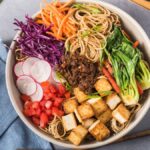Craving delicious and satisfying snacks that align with your flexitarian lifestyle? The key is strategic protein boosting! This guide unveils a world of flavorful, high-protein flexitarian snacks, transforming simple treats into nutritional powerhouses. We’ll explore creative ways to seamlessly integrate protein into your favorite snacks without compromising taste or texture, offering both inventive recipes and simple modifications to existing favorites. Prepare to elevate your snack game and fuel your body with the protein it deserves.
From vibrant fruit salads brimming with protein-packed additions to subtly enhanced veggie sticks and creamy yogurt parfaits bursting with flavor and nutritional benefits, we’ll cover a range of options to suit every palate and dietary need. Learn to harness the power of nuts, seeds, legumes, Greek yogurt, and tofu, understanding their unique nutritional profiles and how to best incorporate them into your daily snacking routine. We’ll also provide practical tips for meal prepping and adjusting protein levels to match your individual activity levels and goals, ensuring you’re always well-fueled and satisfied.
High-Protein Flexitarian Snack Ideas

Flexitarian diets offer a delicious and versatile way to incorporate more plant-based foods while still enjoying the benefits of animal protein. These recipes provide satisfying and nutritious snacks packed with at least 20 grams of protein per serving, perfect for fueling your body and keeping you feeling full and energized.
Five High-Protein Flexitarian Snack Recipes
Below are five original recipes, each designed to provide a substantial protein boost within a flexitarian framework. Each recipe emphasizes fresh, flavorful ingredients and simple preparation methods.
Recipe 1: Mediterranean Quinoa Salad
Ingredients: 1 cup cooked quinoa, ½ cup crumbled feta cheese, ½ cup chopped cucumber, ½ cup chopped tomatoes, ¼ cup Kalamata olives, 2 tablespoons chopped fresh parsley, 2 tablespoons olive oil, 1 tablespoon lemon juice, salt and pepper to taste.
Instructions: Combine all ingredients in a bowl. Mix well and chill for at least 30 minutes before serving. The feta and quinoa provide a significant protein punch.
Recipe 2: Black Bean and Avocado Toast
Ingredients: 2 slices whole-wheat toast, ½ avocado, mashed, ½ cup black beans, rinsed and drained, 1 tablespoon salsa, ¼ cup shredded cheddar cheese (optional).
Instructions: Toast bread. Spread avocado on toast. Top with black beans, salsa, and cheese (if using). Black beans are a fantastic source of plant-based protein, complemented by the healthy fats in the avocado.
Recipe 3: Edamame and Chickpea Salad Sandwich
Ingredients: 1 cup shelled edamame, ½ cup chickpeas, mashed, 2 tablespoons hummus, 1 tablespoon chopped red onion, 2 slices whole-wheat bread.
Instructions: Combine edamame, mashed chickpeas, hummus, and red onion in a bowl. Spread mixture on bread slices. The combination of edamame and chickpeas delivers a powerful protein boost.
Recipe 4: Greek Yogurt with Berries and Nuts
Ingredients: 1 cup Greek yogurt (plain, high-protein), ½ cup mixed berries, ¼ cup chopped walnuts or almonds.
Instructions: Combine Greek yogurt, berries, and nuts in a bowl. The high protein content of Greek yogurt is enhanced by the healthy fats and antioxidants in the berries and nuts.
Recipe 5: Lentil Soup with a Hard-Boiled Egg
Ingredients: 1 cup lentil soup (store-bought or homemade), 1 hard-boiled egg, sliced.
Instructions: Pour lentil soup into a bowl. Top with sliced hard-boiled egg. Lentils are an excellent source of plant-based protein, while the egg adds a significant animal protein component.
Protein Content, Preparation Time, and Cost Comparison
| Recipe | Protein (grams) (approx.) | Preparation Time (minutes) | Estimated Cost per Serving ($) |
|---|---|---|---|
| Mediterranean Quinoa Salad | 22 | 15 | 2.50 |
| Black Bean and Avocado Toast | 25 | 5 | 1.75 |
| Edamame and Chickpea Salad Sandwich | 20 | 10 | 2.00 |
| Greek Yogurt with Berries and Nuts | 28 | 5 | 3.00 |
| Lentil Soup with a Hard-Boiled Egg | 24 | 10 (including egg boiling) | 2.25 |
Tips for Making These Snacks More Appealing to Children
Making healthy snacks fun and engaging is key to encouraging children to eat them. Here are three tips to increase the appeal of these high-protein options.
First, involve children in the preparation process. Let them help wash vegetables, measure ingredients, or assemble the snacks. This hands-on approach fosters a sense of ownership and makes them more likely to try the finished product.
Second, use fun shapes and presentations. Use cookie cutters to shape sandwiches or arrange ingredients in colorful patterns. A visually appealing snack is far more enticing to a child than a plain one.
Third, offer dips and sauces. Hummus, yogurt dips, or even a simple vinaigrette can transform a simple snack into a more exciting experience. Experiment with different flavors to find what your children enjoy.
Boosting Protein in Existing Snacks
Elevating the protein content of your favorite flexitarian snacks is a simple yet effective way to increase your daily protein intake without drastically altering your eating habits. By strategically adding protein-rich ingredients, you can transform familiar snacks into satisfying and nutritious meals that support your health and fitness goals. This section explores practical methods for enhancing the protein levels in common flexitarian snacks.
Protein-Enriched Flexitarian Snack Ideas
Adding protein to your favorite snacks doesn’t require a complete overhaul of your routine. A few thoughtful additions can significantly boost the nutritional value. The following examples demonstrate how easily you can incorporate more protein into your daily diet.
- Fruit Salad: A vibrant bowl of fresh fruit is naturally sweet and refreshing. To boost its protein content, add a dollop (approximately 2 tablespoons) of Greek yogurt, known for its high protein content, or a sprinkle (about ¼ cup) of chia seeds, which are packed with protein and fiber. Imagine the creamy tang of Greek yogurt complementing the sweetness of berries, or the satisfying crunch of chia seeds adding texture to melon chunks.
- Veggie Sticks: A classic crunchy snack, veggie sticks benefit from a protein-rich dip. Instead of relying on creamy, high-fat dips, opt for a hummus (approximately 2 tablespoons), which provides a good source of protein and fiber. Alternatively, a small portion (approximately 1 ounce) of nut butter, such as almond or peanut butter, offers a delicious and protein-packed alternative. Picture the satisfying contrast of the crisp carrots and celery with the smooth, nutty flavor of the chosen dip.
- Popcorn: Air-popped popcorn is a low-calorie snack. To increase its protein, sprinkle approximately 1 tablespoon of nutritional yeast, known for its cheesy flavor and modest protein content, or add a sprinkle (about 1/8 cup) of pumpkin seeds, a good source of protein and healthy fats. The nutritional yeast adds a savory, umami note, while the pumpkin seeds provide a pleasant crunch and additional nutritional benefits.
- Rice Cakes: Plain rice cakes offer a neutral canvas for customization. Top with a thin layer (approximately 1 tablespoon) of avocado, a good source of healthy fats and a moderate amount of protein, and a sprinkle (about 1 tablespoon) of hemp seeds, a complete protein source containing all essential amino acids. The creamy avocado pairs beautifully with the nutty flavor of the hemp seeds, creating a satisfying and nutritious snack.
- Trail Mix: A blend of nuts, seeds, and dried fruits is naturally protein-rich. However, you can further enhance it by adding a measured amount (about ¼ cup) of roasted chickpeas, a surprisingly protein-rich legume. The chickpeas add a satisfying crunch and boost the protein content considerably. Imagine the varied textures and flavors combining to create a delightful and nutritious snack.
Incorporating Protein Powder into Smoothies and Yogurt Parfaits
Protein powder offers a convenient and efficient way to increase the protein content of your smoothies and yogurt parfaits. The following guide details how to seamlessly integrate protein powder into your favorite recipes, exploring various flavor combinations.
- Choose your protein powder: Select a protein powder that aligns with your dietary preferences and goals (whey, soy, casein, pea, brown rice, etc.).
- Measure the protein powder: Follow the recommended serving size on the protein powder packaging. A typical serving is around one scoop (approximately 30 grams).
- Add to your smoothie: Blend the protein powder with your other smoothie ingredients (fruits, vegetables, liquids). Ensure to blend thoroughly to prevent any clumps.
- Incorporate into yogurt parfaits: Layer your yogurt parfait with your favorite fruits, granola, and a sprinkle of protein powder between layers. The protein powder can be mixed with a small amount of liquid (milk or yogurt) to create a smoother consistency before layering.
- Flavor combinations: Experiment with different flavors. Chocolate protein powder pairs well with bananas and berries. Vanilla protein powder complements a variety of fruits and spices. Consider adding spices like cinnamon or nutmeg to enhance the flavor profile.
Protein Sources for Flexitarian Snacks
Choosing the right protein source is crucial for creating satisfying and nutritious flexitarian snacks. The ideal protein will depend on your individual dietary needs, preferences, and the overall flavor profile you’re aiming for. Consider factors like texture, ease of preparation, and storage when making your selection.
Advantages and Disadvantages of Various Protein Sources
Different protein sources offer unique advantages and disadvantages. Nuts and seeds, for instance, provide healthy fats alongside protein, offering satiety and a satisfying crunch. However, their calorie density can be relatively high. Legumes, such as chickpeas or lentils, are excellent sources of plant-based protein and fiber, contributing to digestive health and sustained energy. They require cooking, though, adding preparation time. Greek yogurt delivers a creamy texture and a good dose of protein, but it’s higher in fat and calories compared to some other options and can be less suitable for those with lactose intolerance. Tofu, a versatile soy-based protein, is low in calories and fat, offering a blank canvas for flavor experimentation. However, its texture might not appeal to everyone.
Nutritional Comparison of High-Protein Snack Ingredients
The following table compares the nutritional profiles (per 100g serving) of five high-protein ingredients commonly used in snacks. These values are approximate and can vary depending on the specific product and preparation method.
| Ingredient | Protein (g) | Fat (g) | Fiber (g) |
|---|---|---|---|
| Almonds | 21 | 50 | 12 |
| Greek Yogurt (plain, nonfat) | 10 | 0 | 0 |
| Chia Seeds | 16 | 34 | 34 |
| Lentils (cooked) | 9 | 1 | 7 |
| Tofu (firm) | 8 | 5 | 2 |
Storage and Preservation of High-Protein Snack Ingredients
Proper storage is key to maintaining the quality, freshness, and nutritional value of high-protein snack ingredients. Nuts and seeds should be stored in airtight containers in a cool, dark, and dry place to prevent rancidity. Imagine a pantry, neatly organized, with glass jars containing these ingredients, clearly labeled and dated. Greek yogurt should be refrigerated and consumed within its stated expiration date. Its creamy white texture should remain consistent and free of any unusual odors. Legumes, whether dried or cooked, should be stored in airtight containers in a cool, dry place. Dried legumes can last for extended periods, while cooked legumes should be refrigerated and consumed within a few days. Their vibrant colors and firm texture should remain unchanged. Tofu, similarly, needs refrigeration and should be consumed within a few days of opening. Its firm texture should remain consistent, and it shouldn’t develop any off-putting odors.
Mastering the art of high-protein flexitarian snacking is about more than just adding protein; it’s about enhancing flavor, texture, and overall enjoyment. By exploring the diverse range of protein sources and creative preparation methods Artikeld in this guide, you’ll discover a world of delicious and nutritious snacks that support your healthy lifestyle. Remember, consistent, balanced snacking contributes significantly to overall well-being, so embrace the flexibility and deliciousness that high-protein flexitarian snacks offer. Enjoy the journey to a more energized and satisfied you!
Commonly Asked Questions
What are the best protein powders for flexitarian smoothies?
Whey, casein, soy, brown rice, and pea protein powders are all suitable, choosing one based on your dietary preferences and allergies.
Can I add protein to baked goods like muffins or cookies while maintaining a flexitarian diet?
Absolutely! Incorporate ingredients like mashed chickpeas, ground flaxseed, or protein powder to boost the protein content without drastically altering the taste or texture.
How can I make high-protein snacks appealing to picky eaters?
Involve children in the preparation process, use fun cookie cutters for veggie sticks, and create visually appealing arrangements. Experiment with dips and sauces to add flavor and excitement.
How long can I store homemade high-protein flexitarian snacks?
This depends on the ingredients. Most snacks will last 3-5 days refrigerated, while some may freeze well for longer storage. Always check for freshness and signs of spoilage before consumption.


